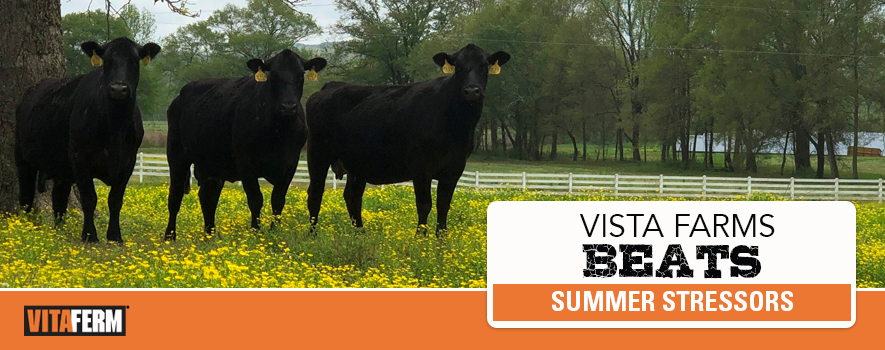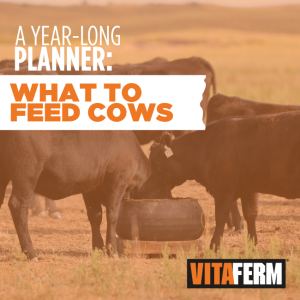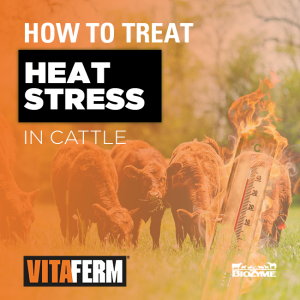Summertime heat can be both a blessing and a curse to those in production agriculture. For those who have planted crops, and received adequate rainfall, the heat is the element that makes those crops grow and thrive. However, for the cattle producer, heat stress can wreak havoc on reproduction, growth and efficiency, as the cattle will expend their energy to cool themselves first for their own survival before they focus on growing a fetus inside them or convert feed to pounds of gain.
However, a progressive cattle producer in Northwest Alabama has discovered with a high-quality mineral program, many of the challenges the operation faced just three years ago, are no longer present. Scott and Sarah McElfresh are the managers of Vista Farms in Fayette, Ala. They raise and market registered Angus bulls and their own replacement females, while retaining ownership on their calves through the feedlot they ship them to in Kansas. Since they heard about the VitaFerm® mineral at an embryo transfer conference a few years ago, they had been wanting to try it. That’s when they learned their local feed mill, Fayette AG was a dealer.
“From where we were to where we are now in our management role, I think the VitaFerm mineral program has really changed the health of our cattle,” Sarah said.
Husband Scott agrees. He said their Angus cattle are shiny and black and shed off with no brown tint to their hair coat. They’ve also experienced better overall conception rates, less heat stress and fly issues and overall increased performance. They primarily feed two products throughout the year, VitaFerm Concept•Aid® 5/S and VitaFerm HEAT®. In addition, they do use the Vita Charge® Cattle Drench and Vita Charge Stress Tubs for weaned calves.
Improved Conception Rates
Vista Farms has experienced an increase in their conception rates since they converted to the VitaFerm mineral program. Not only are more of their cows getting bred using advanced reproductive methods like artificial insemination (A.I.) and embryo transfer (E.T.), more of their cows are staying bred through the summer and having a live calf. In addition, their pasture exposure cows tend to breed back quicker so they get a more uniform group of calves earlier in the season when they turn their bulls out.
Beating Summer Stressors
Perhaps one of the biggest benefits that Scott and Sarah have noticed is with the heat stress and fly control they find in the VitaFerm HEAT mineral. In addition to being a highly-fortified mineral, VitaFerm HEAT contains three key ingredients to help combat heat stress: Amaferm®, a precision-based prebiotic that impacts intake, feed digestibility and nutrient absorption for maintaining performance, a blend of plant extracts to help maintain circulation and support animal performance in both extreme heat and fescue situations, and garlic, to deter insects.
Scott said since they’ve started feeding VitaFerm HEAT, their cattle aren’t bunched up in water or mud or laying under the shade to cool themselves during the hottest part of the day.
“If they are grazing, they are gaining and if they are gaining, there is a payoff there,” Scott said. “When cattle are laying in the shade or standing in the mud, they are not consuming forage and therefore they are not growing. We raise our own bulls and our own replacement heifers, so we like to see the cattle out grazing, out gaining weight, where they are more profitable than when they are under the shade.”
Along with the added performance he sees from more daytime grazing, he also sees less issues with flies bothering his cattle. He said they are present, but usually hovering about three feet above the cattle’s back.
“We run our bulls in river bottom 200 yards from chicken houses, and since we started them on VitaFerm HEAT, they don’t have flies on them. The product is just amazing,” Scott said.
Improved Health
The McElfresh duo said they have had to treat fewer sick calves since they switched their mineral program. And when they do have to treat one, they give it a dose of Vita Charge – either the Cattle Drench or Gel – which seems to make the vaccine work more quickly and allow the calf to get back to eating faster.
“We used to struggle with hairy wart or feet issues, but we really haven’t seen those issues since we switched mineral programs,” Scott said.
And even though they have a rigorous vaccination program for calves they are sending to the Kansas feedyard, they give their calves Vita Charge Drench about a week before they get on the truck to help reduce their stress. On arrival, they have received reports that their calves come off the trailer in good shape and go straight to the bunk.
According to Google, the average summertime high temperature in Fayette, Ala., is 91-degreees. Add in the humidity, flies and other stressors, and being a bovine might not be the ideal. Unless you are on Vista Farms. The progressive managers there have found a quality nutrition program that keeps their cattle healthy, grazing and performing, even during the hottest times of the year.



